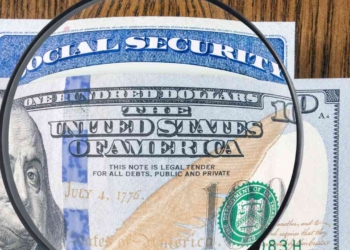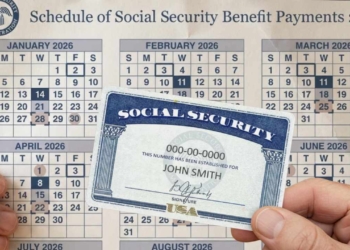Donald Trump’s recent assertions about 12.4 million Social Security recipients supposedly over age 120 and 135,000 individuals allegedly beyond age 160 have ignited controversy. Sitting in his flamboyant chair, in the Oval Room, the President of the United States of America labels this a “massive fraud” draining the system.
In rallies and social media posts, Trump frames these records as evidence of systemic theft: “Taxpayer dollars are funding benefits for dead people” on an “unimaginable scale,” as he stated recently. He contends eliminating these “phantom beneficiaries” would solve Social Security’s financial challenges, blaming “government incompetence” for allowing the alleged fraud.
Trump Points to 135,000 Over-160 Records as Fraud to Social Security
The figures Trump cites exist in the Social Security Administration’s (SSA) Numident database: a repository of all issued Social Security numbers. However, these records stem from technical glitches in the agency’s 60-year-old COBOL-based system.
135,000 People Over 160: Trump Blasts Social Security Fraud pic.twitter.com/ybWcltaHtS
— Janet™ (@Janet_sm145) August 15, 2025
When birthdates are missing or incomplete, the system defaults to January 1, 1800, creating false records of super-centenarians. The actual data, corroborated by experts, goes like this:
- A July 2024 SSA Inspector General report confirms improper payments totaled just 0.84% ($71.8 billion) of the $8.6 trillion distributed between 2015-2022.
- Over 95% of these errors involved living recipients receiving incorrect amounts, yet not payments to deceased individuals.
- Since September 2015, the SSA automatically halts payments to anyone exceeding 115 years old.
And there’s more to contrast Trump’s affirmations: The SSA’s 2023 internal review found 18.9 million unmarked deceased in records for people born before 1920. Crucially, the agency noted “virtually none” of these receive active benefits. Correcting these legacy records would cost $9 million – deemed unjustified given the negligible operational impact.
Independent experts confirm Social Security maintains one of the lowest improper payment rates across federal programs. Economist Chuck Blahous (Mercatus Center) notes: “The system’s actual error rate is lower than Medicare or Medicaid by significant margins.”
Trump’s Social Security fraud claim cleared up
Having said all these things, the President’s assertions could be labeled as whatsoever incorrect, since 12.4 recipients over 120 years old, and records about people with 160 years old, are “digital artifacts” in a very old computer database, and they’re not actually living beneficiaries.
Zero evidence shows these records generate payments: Active fraud prevention systems block such disbursements. The “massive fraud” narrative collapses under scrutiny: Improper payments remain below 1% – mostly involving living recipients.
The Numident glitches represent outdated technology issues, not evidence of orchestrated fraud, as stated in the SSA Inspector General Report (July 2024), SSA Numident System Audit (2023), Congressional Research Service Analysis, Interviews with Chuck Blahous (Mercatus Center) and Sita Nataraj Slavov (George Mason University).
This IS true: Social Security funds may run dry in a few years
The Social Security system confronts a projected funding shortfall, primarily driven by demographic shifts and structural imbalances between program income and expenses. The U.S. population is rapidly aging, with swelling ranks of baby boomers entering retirement while birth rates decline – resulting in fewer working-age contributors funding the system through payroll taxes.
According to 2024 projections from the Social Security Administration (SSA), the Old-Age and Survivors Insurance (OASI) trust fund could deplete its reserves by 2035 without congressional intervention. This countdown stems from benefit payouts consistently exceeding tax revenues as beneficiary numbers outpace workforce growth. Compounding the strain, increased life expectancy means retirees draw benefits for longer periods.
Social Security operates on a “pay-as-you-go” model where current workers’ taxes fund current retirees’ benefits. But payroll tax revenues haven’t kept pace with benefit costs due to two critical pressures:
- Income inequality: More earnings concentrate above the taxable maximum ($168,600 in 2024), shrinking the contribution base
- Wage stagnation: Real wage growth for middle-income workers remains sluggish, limiting tax revenue expansion
What’s more, the OASI trust fund relies heavily on interest earnings from U.S. Treasury bonds where surplus funds are invested. With deficits now draining these reserves, the fund’s $2.8 trillion buffer is steadily shrinking. If reserves fully deplete, the SSA would need to rely solely on incoming payroll taxes, covering only about 75-80% of scheduled benefits starting in 2035.
Unlike other federal programs, Social Security cannot deficit-spend. Current law prohibits the SSA from borrowing to cover benefit gaps. This creates a legal and mathematical imperative for solutions: without reforms, all beneficiaries – regardless of income or age – would face automatic 20-25% benefit cuts upon trust fund exhaustion.







